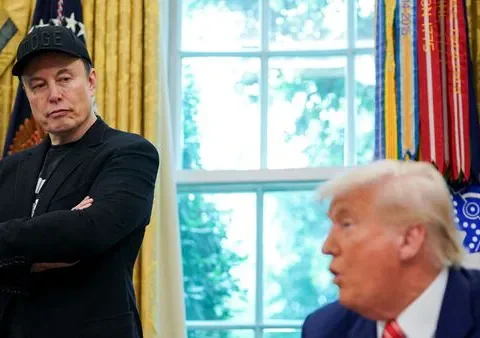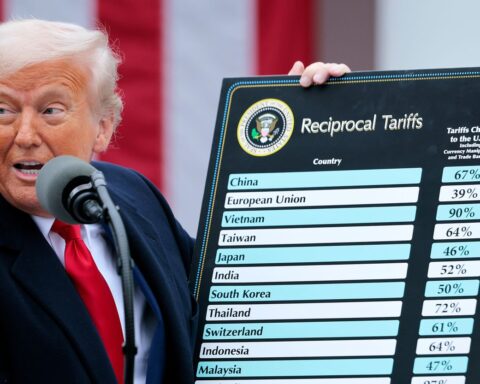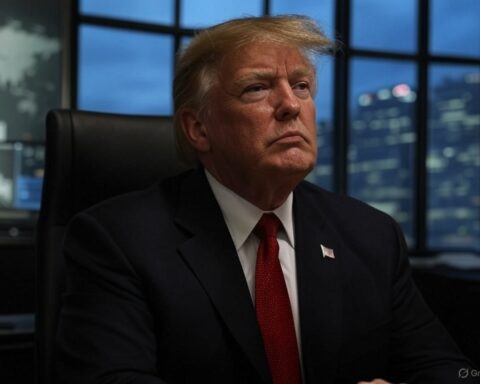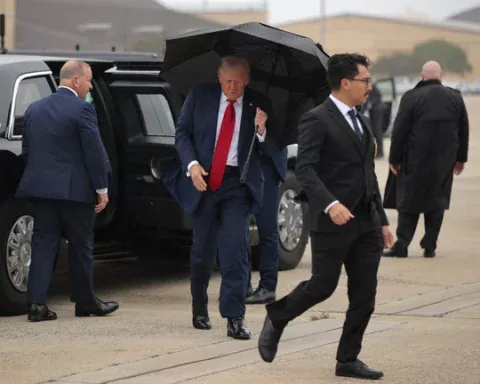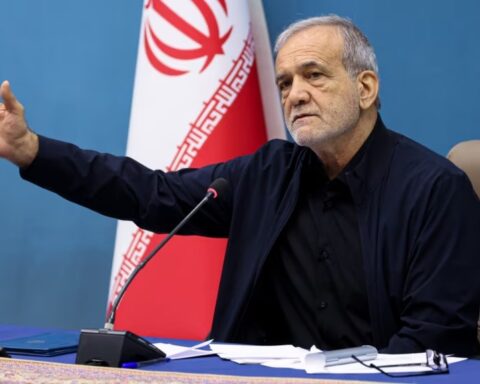Asian markets have plunged into chaos as President Donald Trump’s escalating global tariff turmoil deepens, sending shockwaves through economies heavily reliant on exports to the U.S. The aggressive trade policy, featuring a 10% blanket tariff on all imports and steeper duties on nations like China and Vietnam, has triggered a brutal sell-off, with major indices from Tokyo to Hong Kong dropping as much as 10% in a single day.
Trump’s refusal to back down—calling the measures a necessary “medicine” for trade imbalances—has sparked widespread panic, erased trillions in market value, and fueled fears of a looming recession. As retaliatory tariffs from China and others pile on, the financial fallout has left investors reeling and global leaders scrambling for a response.
The crisis hit a fever pitch on April 7, 2025, as Asian markets opened to devastating declines following a weekend of intensifying trade tensions. Japan’s Nikkei 225 tumbled nearly 9%, its bank stocks shedding up to 17%, while Hong Kong’s Hang Seng Index cratered over 10%, marking one of its worst days since the 2008 financial crisis.
Taiwan’s Taiex plummeted 9.7%, triggering circuit breakers for giants like TSMC, and China’s CSI 300 fell 6.31%, dragging the yuan to a three-month low. The U.S. wasn’t spared either—stock futures plunged Sunday night, with the S&P 500 down 4.6% and Nasdaq futures off 5.3%, signaling another brutal day ahead for Wall Street after its worst week since 2020.
The Tariff Trigger: A Bold Gambit Goes Awry
The turmoil traces back to Trump’s April 2 “Liberation Day” announcement, where he unveiled a sweeping tariff regime aimed at “leveling the playing field.” The policy slapped a 10% duty on all U.S. imports, with reciprocal rates hitting specific nations—34% on China, 46% on Vietnam, and 24% on Japan—based on perceived trade imbalances.
Treasury Secretary Scott Bessent framed it as a negotiation tool, claiming over 50 countries had reached out by Sunday to discuss deals. Yet the immediate effect was catastrophic, with China retaliating by imposing 34% tariffs on all U.S. goods, effective April 10, sending oil prices below $60 a barrel and amplifying global recession fears.
Trump, speaking aboard Air Force One late Sunday, doubled down, insisting “sometimes you have to take medicine to fix something.” He dismissed market losses as a necessary step, boasting on Truth Social that tariffs were already generating “tens of billions” for the U.S. His advisers, like Peter Navarro, echoed this optimism on Fox News, predicting a historic stock market boom once trade balances shift. Critics, however, see a dangerous misstep—analysts like Oxford Economics’ Ryan Sweet warn of a GDP hit, with inflation and layoffs looming if the policy persists.
Asian Markets Plunge as Trump’s Global Tariff Turmoil Deepens
Nowhere has the pain been more acute than in Asia, where export-driven economies face an existential threat. Hong Kong’s Hang Seng Index led the carnage, dropping 10.37% by midday Monday, with losses spanning tech, healthcare, and consumer sectors. Japan’s Nikkei 225 shed nearly 9%, erasing weeks of gains, while Taiwan’s market saw trading halts as stocks like TSMC and Foxconn plummeted. South Korea’s KOSPI fell 5%, and Australia’s ASX 200 lost 6.3%, its worst day since the COVID-19 pandemic, reflecting the region’s vulnerability to U.S. trade disruptions.
China’s retaliation has compounded the crisis—its CSI 300 index fell 6.31%, and oil prices sank over 3% Monday after a 7% Friday drop, signaling a collapse in global demand expectations. “Asia is likely to feel a disproportionate brunt of this turmoil,” said Frank Lavin, a former U.S. Commerce official, noting the region’s heavy reliance on U.S. exports. Taiwan’s tech sector, a linchpin in global supply chains, faces particular peril, with analysts warning of ripple effects for everything from smartphones to semiconductors.
Wall Street’s Echoing Collapse
The U.S. market has mirrored Asia’s misery, with Wall Street capping its worst week since the 2020 pandemic. The S&P 500 lost nearly $5 trillion in value over two days, plunging 6% Friday, while the Dow shed 2,231 points—a 5.5% drop. The Nasdaq Composite entered bear market territory, down over 20% from its December peak, with tech giants like Apple and Nvidia losing over 7% in a single session. Sunday night’s futures signaled more pain—Dow futures off 1,531 points, S&P 500 futures down 4.6%—as investors fled to bonds, driving yields lower in a flight to safety.
The market rout has shredded a post-election rally fueled by hopes of a business-friendly Trump agenda. Instead, his tariffs have sparked a reckoning, with JPMorgan forecasting a two-quarter U.S. recession by late 2025. “The market is screaming at Trump to stop,” one analyst told CNN, highlighting a stark disconnect between the White House’s bravado and Wall Street’s despair. Hedge fund titan Bill Ackman, a Trump supporter, warned of an “economic nuclear winter” unless the policy shifts, a rare dissent from within the president’s orbit.
Global Retaliation and Economic Fallout
The tariff war has ignited a global backlash. China’s 34% counter-tariffs have slammed U.S. exporters, while the EU mulls targeted reprisals—potentially hitting Tesla—and the UK’s Keir Starmer vows to “shelter” British businesses. Canada and Mexico, facing a 10% baseline plus a 25% auto tariff, are in talks but haven’t ruled out retaliation despite USMCA protections. Smaller economies like New Zealand (NZX 50 down 3.5%) and Thailand (36% tariff) are caught in the crossfire, with little leverage to resist.
The International Monetary Fund has warned of a global recession if the standoff persists, a view echoed by the BBC’s coverage of UK pensioner fears. Oil’s slide below $60 a barrel—the lowest since April 2021—underscores demand worries, while gold surged to $3,148 an ounce as a safe haven. “This is a perfect storm,” said a Tokyo-based economist, noting Asia’s export economies face a brutal reckoning as trade barriers rise.
Trump’s Defiance Amid the Storm
Despite the chaos, Trump remains unbowed. “Tariffs are a beautiful thing to behold,” he posted on Truth Social, urging Americans to “hang tough” and promising long-term gains. Speaking Sunday, he denied engineering the sell-off, claiming he couldn’t predict market reactions but saw negotiations unfolding—“lots of countries are dying to make a deal.” Navarro reinforced this on Fox News, dismissing losses as short-term noise, while Bessent told NBC’s “Meet the Press” that over 50 nations were engaging, though he cautioned talks would take time.
Critics see a president out of touch. “This isn’t medicine—it’s poison,” one commentator quipped, drawing parallels to the 1930 Smoot-Hawley Tariff Act that deepened the Great Depression. Even Elon Musk, a key Trump ally, clashed with Navarro over the tariffs’ impact, exposing rare fissures in the administration. Democrats mocked Trump golfing in Florida Sunday, with Senator Adam Schiff calling it his presidency’s “enduring image” amid the crisis.
The Human and Economic Cost
Beyond the numbers, the tariffs’ toll is palpable. U.S. consumers face looming price hikes, with Walmart reporting a 15% sales spike as shoppers stockpile goods. Businesses are reeling—Jaguar Land Rover paused U.S. shipments, and farmers brace for export losses, though Agriculture Secretary Brooke Rollins hinted at aid. Retirees told NBC their 401(k)s are “shrinking in horror,” with one, Paula, asking, “How do we survive this?”
In Asia, Vietnam’s footwear sector and Taiwan’s tech giants face existential threats, threatening jobs and global supply chains. “This isn’t a negotiation—it’s a sledgehammer,” one economist told CNN, capturing the despair of workers and investors alike. The disconnect between Trump’s optimism and the ground-level pain has fueled protests, with critics decrying a policy that punishes the vulnerable while chasing an elusive trade victory.
What Lies Ahead?
As markets brace for another volatile week, the path forward is uncertain. The Federal Reserve may slash rates by May if recession signals intensify, while Asian regulators—like Japan’s central bank—eye currency interventions as the yen surges. Trump’s team insists the pain is temporary, with Navarro predicting a historic boom and Bessent citing Vietnam’s talks as progress. Yet without de-escalation, analysts see irreversible damage—JPMorgan’s recession forecast could worsen if retaliation escalates.
For now, the world watches anxiously. Whether Trump’s “medicine” heals or harms depends on his next move—and the global response. Shoppers, workers, and investors from New York to Tokyo are left grappling with a policy that’s anything but beautiful, as the tariff storm shows no signs of abating.
Focus Keywords: Asian markets plunge, Trump tariff turmoil, global trade war, stock market crash, economic recession





